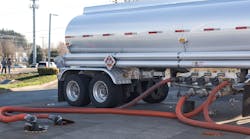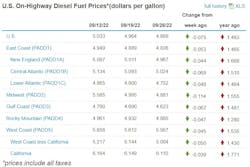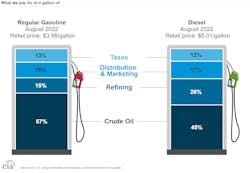The U.S. average price for a gallon of diesel fuel has fallen once more after three months of almost continuous declines, but gasoline is up slightly, according to the U.S. Energy Information Administration (EIA).
Diesel was down 7.5 cents for the week of Sept. 26 to $4.889 per gallon, sinking further below the $5 mark since last week, according to EIA. The U.S. average for trucking's main fuel, however, was heavily influenced by a precipitous 11.4-cent decline in the Midwest. Other regions of the nation were down but much less, according to EIA data, seeing their prices drop between 4 cents and 7 cents.
Diesel has been trending downward since it set a record of $5.81 per gallon the week of June 20. The nationwide average, even after those months of mostly uninterrupted declines, is still $1.483 more expensive than it was a year ago, according to EIA.
See also: Diesel dips below $5 a gallon
Gasoline prices high along hurricane concern
Gasoline’s national average price rose somewhat in the past week, increasing 5.7 cents to $3.711 per gallon, according to EIA. Motor club AAA measured the average price of the consumer fuel to be $3.747 per gallon on Sept. 27, a 1.8-cent increase from the day before and a 7.3-cent increase from a week ago.
“Slack demand and lower oil prices should take some pressure off rising gas prices,” Andrew Gross, AAA spokesperson, said in a press release. “But Hurricane Ian could cause problems, depending on the storm’s track, by disrupting oil production in the Gulf of Mexico and impacting large coastal refineries.”
The price for a barrel of West Texas Intermediate (WTI) oil reached $76.71 on Sept. 26. This is a low point not seen since early January 2022, as the market continues to worry that efforts by the Federal Reserve to curb inflation could lead to a recession, according to AAA analysis. If a recession occurs, crude demand and prices would likely decline. For this week, crude prices could continue to decrease if recession fears persist. The price of WTI crude was slightly higher at the market’s opening on Sept. 27—$77.89, a $1.18 increase from yesterday.
Additionally, EIA’s latest weekly report showed that total commercial crude inventories increased by 1.2 million barrels to 430.8 million.






